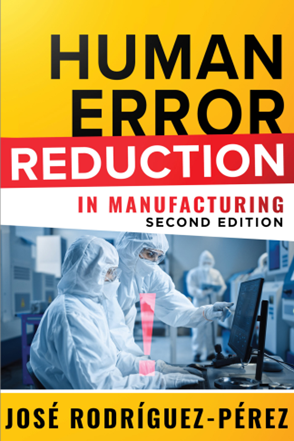读者您好!
企业在解决内外部各种问题的过程中,分析根本原因的这一环节有时候是非常头痛的,不知不觉间常常会得到“受人为因素影响”结论。但该问题是否真的是受到了“人为原因”的影响呢?要准确地判断这一点似乎有点困难。
在此,本人将美国质量学会(ASQ)一本著作中推荐的“诊断工具”翻译出来,供大家在进行原因分析时参考,以帮助大家正确地进行“人为原因”的分析。如有不妥之处,请以英文为准。
英文正版书籍请向ASQ官网购买。

A DIAGNOSTIC TOOL
|
“我”(书作者)列出了50个问题,可在任何人为失误调查过程中用作指导。这些问题的目的是更好地了解与所调查问题相关的人为因素。这不是一份简单的清单,应该与常规的根本原因分析工具(如因果图和故障树分析)一起使用。这些问题的答案将为以下调查要素提供有价值的信息: |
|
|
● |
Identifying contributing root causes 找出根本原因 |
|
● |
Identifying situational factors 确定情景因素 |
|
● |
Identifying latent factors 识别潜在因素 |
|
● |
Identifying absent or insufficient control barriers 确定缺少和不充分控制屏障 |
|
Classification of Human Errors/Violations 人为失效/违规的分类 |
|
|
1. |
Did the person unconsciously perform the task erroneously (commission error)? 此人是否无意识地错误执行了任务(委托错误)? |
|
2. |
Did the person unconsciously miss the task or any step (omission error)? 此人是否无意识地漏掉了任务或任何步骤(遗漏错误)? |
|
3. |
If this was a documentation omission, is the record designed to identify omissions easily? 如果是文件有遗漏,设计的记录是否便于识别遗漏? |
|
4. |
Did the person fail to recognize a defect, message, signal, and so on (recognition error)? 此人是否未能识别缺陷、信息、信号等(识别错误)? |
|
5. |
Did the person intentionally perform the task differently than specified in the procedures or work instructions? 此人是否故意以不同于程序或工作指导书规定的方式执行任务? |
|
Procedure Quality and Content 程序质量和内容 |
|
|
6. |
Are there formal (written) instructions to perform this task? 是否有执行这项任务的正式(书面)指导书? |
|
7. |
Were procedures or work instructions available in the immediate area where the task was performed? 执行任务的邻近区域是否有程序或工作指导书? |
|
8. |
Did the procedures or work instructions change recently? 程序或工作指导书最近是否有变更? |
|
9. |
Did the person read the procedures or work instructions while executing the task? 此人在执行任务时是否阅读了程序或工作指导书? |
|
10. |
Did the procedures or work instructions use specific details rather than a qualitative description (slowly, soon, few, well, and so on)? 程序或工作指导书是否使用了具体细节,而不是定性描述(慢、快、少、好等)? |
|
11. |
Does the person need to process or interpret information to execute this task? 执行这项任务需要处理或解释信息吗? |
|
12. |
Is there consistency in how other people are performing this task? 其他人执行这项任务的方式是否一致? |
|
13. |
Is the error related to numbers or alphanumeric information (specifications, batch numbers)? 错误是否与数字或字母信息(规格、批号)有关? |
|
Training 培训 |
|
|
14. |
Was the person formally trained on the task or procedure? 该人员是否接受过有关任务或程序的正式培训? |
|
15. |
Is the training method appropriate for this task? Describe the method used. 培训方法是否适合这项任务?描述所使用的方法。 |
|
16. |
Does the training cover this specific task? 培训是否涵盖这项具体任务? |
|
17. |
How long was the training for this specific task? 这项具体任务的培训时间有多长? |
|
18. |
How recently did the person receive the training? 此人最近接受过什么培训? |
|
19. |
Who trained this person? 谁培训的这个人? |
|
20. |
Who trained the other people who did the task correctly? 是谁培训了其他正确完成任务的人? |
|
21. |
How was the competence of the person assessed after completion of the training? 培训结束后,如何评估有关人员的能力? |
|
22. |
Was the training effectiveness evaluated? Describe the method used. 是否对培训效果进行了评估?说明使用的方法。 |
|
Situational Factors 情景因素 |
|
|
23. |
Are other tasks interrupting the performance of this task? 其他任务是否会干扰这项任务的执行? |
|
24. |
Have there been any recent interventions in the area affected by the nonconformity? 最近是否对不符合的区域进行过干预? |
|
25. |
Were all the area personnel present when the error occurred? 错误发生时,所有区域人员是否都在场? |
|
26. |
Was the supervisor or group leader present when the error occurred? 错误发生时,主管或组长在场吗? |
|
27. |
Did the error occur during overtime? 错误发生在加班期间吗? |
|
28. |
Did the error occur prior to or after a break or shift change? 错误发生在休息或换班之前还是之后? |
|
29. |
Did the error occur prior to or after a shutdown or vacation period? 错误是在停机或休假之前还是之后发生的? |
|
30. |
Was it a situation with a very tight deadline? 是时间紧迫的情况吗? |
|
31. |
Was it a situation of competing priorities? 这是优先事项相互竞争的情况吗? |
|
Latent Factors 潜在因素 |
|
|
32. |
Did the person work from memory while executing this task? 在执行这项任务时,他是凭记忆工作的吗? |
|
33. |
Was the person working in autopilot mode because he/she was very familiar with the task? 此人是否因为非常熟悉任务而在自动驾驶模式下工作? |
|
34. |
Was the person performing any other task concurrently (multitasking)? 此人是否在同时执行其他任务(多任务处理)? |
|
35. |
Does the task require processing too much information or focusing on too many things at the same time? 任务是否需要处理太多信息或同时关注太多事情? |
|
36. |
Does the task require the person to follow a specific sequence of steps? 这项任务是否要求当事人遵循特定的步骤顺序? |
|
37. |
Was the area's layout or workspace overcrowded? 该区域的布局或工作空间是否过于拥挤? |
|
38. |
Was the area disorganized, requiring people to have to move around to perform tasks? 该区域是否杂乱无章,需要人们四处移动才能完成任务? |
|
39. |
Were the working conditions comfortable (noise, temperature, humidity, illumination [well-lit with bright light], etc.)? 工作条件是否舒适(噪音、温度、湿度、照明[光线充足、明亮]等)? |
|
40. |
Is the system or process intuitive enough to be understood easily? 系统或流程是否足够直观,易于理解? |
|
Control Related 相关控制 |
|
|
41. |
Is there any control (barrier) in place to specifically avoid this failure? 是否有任何控制措施(屏障)来专门避免这种故障? |
|
42. |
Has the control been challenged to determine if it is working? 是否对控制措施进行过质疑,以确定其是否有效? |
|
43. |
Are there any job aids or checklists to perform this task? 是否有执行这项任务的工作辅助工具或检查表? |
|
44. |
Are their format/contents appropriate for clear interpretation? 它们的格式/内容是否适合清晰解读? |
|
45. |
Did the employee use the job aid(s)? 员工是否使用了工作辅助工具? |
|
46. |
Does this task include a second person verification or checking? 这项任务是否包括第二人验证或检查? |
|
Skill Fading 技能退化 |
|
|
47. |
Is this the first time the person performed this task? 他是第一次执行这项任务吗? |
|
|
a. If it’s not the first time, when was the last time he/she performed this task? a. 如果不是第一次,他/她上一次执行这项任务是什么时候? |
|
|
b. If it’s not the first time, how often does the person perform this task? b. 如果不是第一次,此人多长时间做一次这项工作? |
|
48. |
How many other people do the same task correctly under the same conditions? 在相同条件下,还有多少人能够正确完成同样的任务? |
|
49. |
Has the person performed the task correctly earlier? 他之前是否正确地完成了任务? |
|
50. |
How often did this (or similar) error occur during the last year? 去年发生这种(或类似)错误的频率是多少? |
希望对您的问题解决过程有所触动,感谢阅读!
相关在线课程
|
掌握七问分析法(5W2H),提升结构化思维力 |



